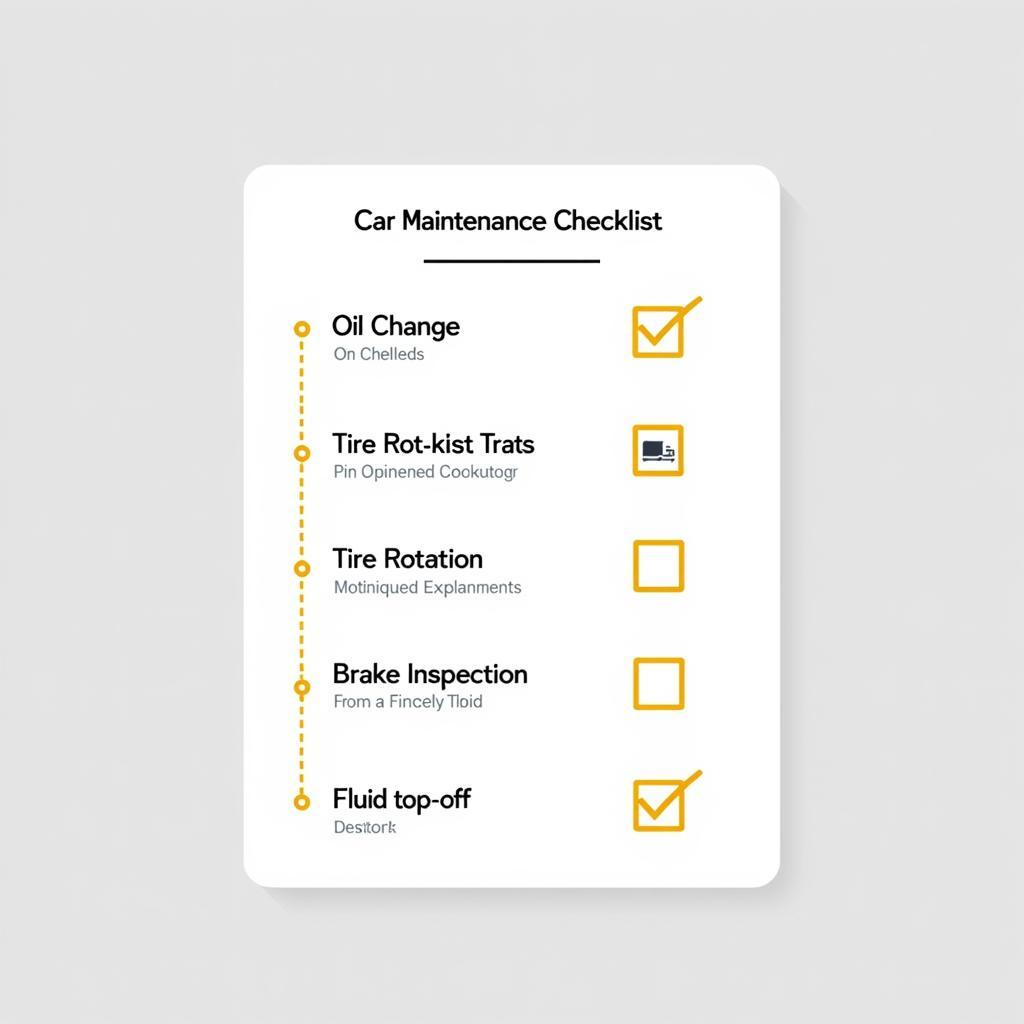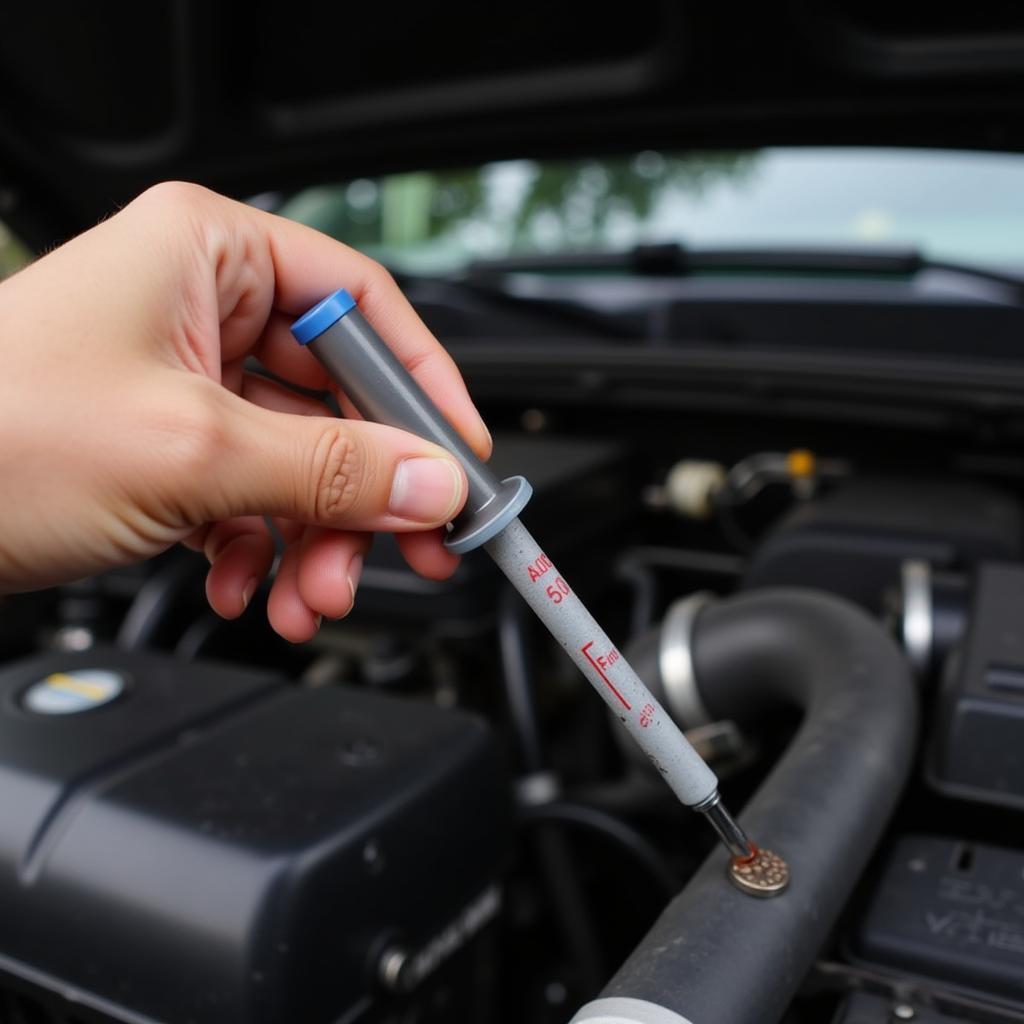Maintaining your car is crucial for its longevity, performance, and safety. Knowing when to do maintenance on your car can save you money in the long run and prevent unexpected breakdowns. This guide will provide you with a comprehensive understanding of car maintenance schedules, best practices, and tips to keep your vehicle running smoothly.
Similar to a reliable low maintenance used car, preventative maintenance is key. We’ll explore various maintenance tasks, from routine checks to more complex procedures, and help you determine the optimal schedule for your specific needs.
Understanding Your Car’s Maintenance Needs
Every car is different, and their maintenance needs vary based on factors like make, model, age, driving conditions, and even the climate you live in. Understanding these factors will help you tailor a maintenance schedule that’s perfect for your vehicle. Neglecting regular maintenance can lead to costly repairs down the road.
 Car Maintenance Checklist
Car Maintenance Checklist
How Often Should You Get Maintenance on Your Car?
A common question is, “How often should you get maintenance on your car?” The answer isn’t always straightforward. While your owner’s manual is the best resource for specific recommendations, there are general guidelines to follow. These guidelines typically include recommendations for both time-based and mileage-based intervals.
A good resource to familiarize yourself with maintenance intervals is this article on how often should you get maintenance on your car. It provides valuable information on different types of maintenance and their recommended frequency.
What are the Key Maintenance Tasks?
Several key maintenance tasks should be performed regularly. These include oil changes, tire rotations, brake inspections, fluid top-offs, and air filter replacements. Each of these tasks plays a vital role in keeping your car in top condition. Let’s delve deeper into each of these tasks.
Oil Changes
Oil changes are essential for lubricating your engine and preventing wear and tear. Generally, oil changes are recommended every 3,000 to 5,000 miles, but this can vary based on your car and the type of oil you use.
Tire Rotations
Tire rotations help ensure even wear on your tires, extending their lifespan and improving handling. Rotating your tires every 5,000 to 7,500 miles is generally recommended.
 Tire Rotation Diagram
Tire Rotation Diagram
Brake Inspections
Regular brake inspections are crucial for safety. Inspecting your brakes every 12,000 miles or annually is generally recommended.
Fluid Top-Offs
Maintaining proper fluid levels is essential for various systems in your car, including the cooling system, power steering, and transmission. Check your fluid levels regularly and top them off as needed.
Air Filter Replacements
Replacing your air filter helps ensure clean air enters your engine, improving fuel efficiency and performance. Air filters should typically be replaced every 12,000 to 15,000 miles.
“Regular maintenance isn’t just about keeping your car running; it’s about ensuring your safety and the safety of others on the road,” says automotive expert, Michael Stevens, ASE Certified Master Technician.
What are the Signs Your Car Needs Maintenance?
Sometimes, your car will give you clear signs that it needs maintenance. These signs can include unusual noises, vibrations, warning lights, or changes in performance. Paying attention to these signs and addressing them promptly can prevent minor issues from becoming major problems.
 Car Dashboard Warning Lights
Car Dashboard Warning Lights
Creating a Personalized Car Maintenance Schedule
Using the information in your owner’s manual and considering your driving habits and environment, you can create a personalized car maintenance schedule. This schedule should include all the recommended maintenance tasks and their respective intervals. Sticking to this schedule will help you keep your car in optimal condition and avoid costly repairs.
This checklist on [car maintenance best practice checklist](https://autotippro.com/car maintenance-best-practice-checklist/) can assist you in creating a comprehensive and effective maintenance plan. A well-maintained car is a safe and reliable car.
“A proactive approach to car maintenance is always the best approach. It saves you money and headaches in the long run,” adds Sarah Johnson, automotive engineer and consultant.
When to Seek Professional Help
While some maintenance tasks can be performed at home, others require professional expertise. Knowing when to seek professional help is important. Complex repairs or tasks requiring specialized tools are best left to qualified mechanics.
For those interested in teaching or learning more about car maintenance, lesson plans for teaching car maintenance can be a valuable resource. Regular maintenance ensures your car operates safely and efficiently.
 Mechanic Working on Car Engine
Mechanic Working on Car Engine
Conclusion
When Should You Do Maintenance On Your Car? The answer depends on a variety of factors, but following the guidelines in this article and your owner’s manual will help you keep your car running smoothly for years to come. Remember, preventative maintenance is the key to a safe, reliable, and cost-effective driving experience. Contact us at AutoTipPro for any questions or assistance you may need. Our phone number is +1 (641) 206-8880 and our office is located at 500 N St Mary’s St, San Antonio, TX 78205, United States. We’re always happy to help!
This resource regarding a club car golf cart maintenance checklist highlights the importance of preventative maintenance for all types of vehicles, even recreational ones. Remember, maintaining your car is an investment in its longevity.






Leave a Reply